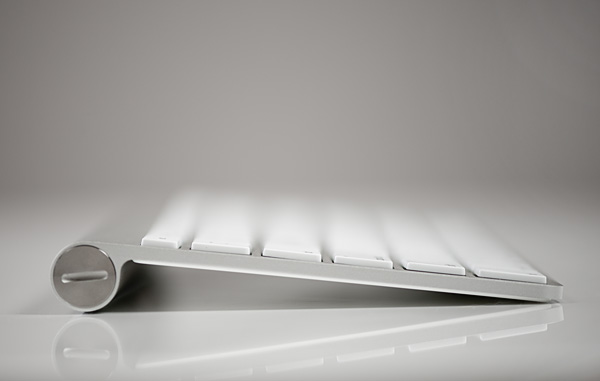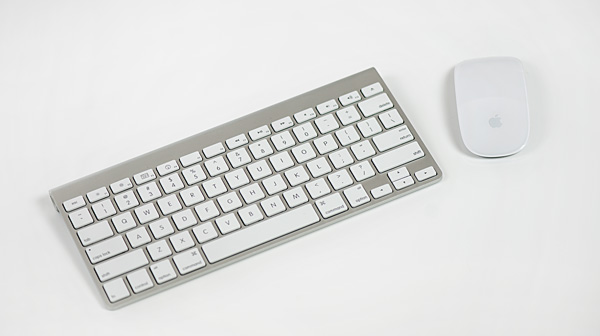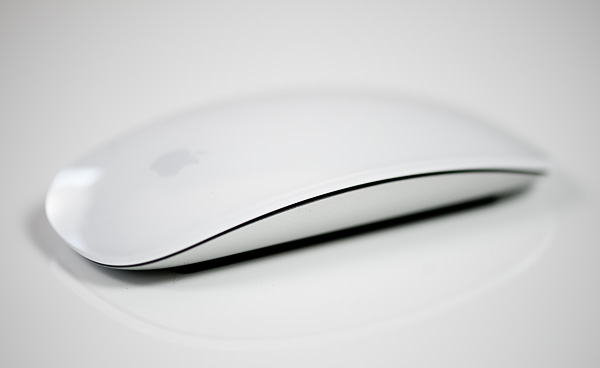The 27-inch Apple iMac Review (2011)
by Anand Lal Shimpi on May 27, 2011 2:30 AM ESTThe Peripherals
I've never been a fan of wireless peripherals - I didn't want more things to charge. Last year I finally broke down and bought a wireless mouse: Microsoft's Wireless Mobile Mouse 4000. I didn't buy it for mobility, I just liked the form factor.
The iMac comes with all wireless peripherals. In fact, if you stick with WiFi for network access, there's only a single cable you need going to the iMac: power. By default you get Apple's Wireless Keyboard and a Magic Mouse.
The Wireless Keyboard is a Bluetooth keyboard that runs off of two AA batteries. It pairs effortlessly with the iMac and I didn't encounter any issues with interference in using it. The keyboard seems to burn through batteries quicker than the mouse, perhaps that's because I type far too much or there's an issue with power management under OS X. After a week of use I'm down to 81% on a fresh pair of batteries (this is my second set).
The keyboard itself is a lot like Apple's standard aluminum keyboard, just wireless and more compact. Apple chopped off the dedicated home/end key island as well as the numeric keypad. Under OS X Cmd + Left/Right Arrow take the place of Home/End for me so part of the sacrifice isn't a problem, but the missing numeric keypad is. I do entirely too much data entry (ahem, benchmarks) to not have a dedicated numeric keypad, and for some reason Apple doesn't offer the Wireless Keyboard with one.
If you don't type tons of numbers every day however, the Wireless Keyboard is really nice. Apple had to stick a function key to the left of the control key, which is a bit bothersome (leave my control/option/cmd row alone) but it's nothing you can't get used to. The footprint is great. I have a giant desk, but I always seem to run out of desk space. The Wireless Keyboard makes it so that I can reclaim a small amount of high value desk area.
Typing feel and keyboard angle are both great - no complaints there. I'm a fan of Apple's keyboards.
Pointing devices designed in Cupertino are another story entirely. I've never liked Apple's mice. It was a big enough problem that when I first tried my Month with a Mac experience I ditched Apple's mouse. There was no way I was going to give the platform a fair shake if I had to use that thing. Since then Apple has at least enabled double clicking - the surface of the Magic Mouse is touch sensitive, click with your right finger and you get a right click. The Magic Mouse has no scroll wheel but drag your finger around on its surface and you get the best scrolling experience on a physical mouse.
The Magic Mouse is also a Bluetooth device that quickly pairs with the iMac. I noticed under Windows there's always a second or two of lag before it recognizes the mouse whereas it's useable as soon as you can see it under OS X.
My complaints about the Magic Mouse are three-fold. As I've mentioned before, the Magic Mouse doesn't have soft rubber feet that glide around on your desk. Instead you get two hard plastic strips that just seem to scrape against all surfaces. Tracking isn't a problem, but it's not a pleasant experience.
The other issue I have is the form factor itself. Microsoft's Wireless Mobile Mouse 4000 is small but it has a nice curve to it that seems to match my hand very well. The Magic Mouse on the other hand doesn't conform to any part of my body. I can lay my hand flat on it but either I'm not conditioned to do that or that's not a very comfortable way to use the mouse for long periods of a time.
Finally there's the clicking noise it makes. Modern mice seem to have a solid but more muted click, whereas the sharp click of the Magic Mouse reminds me of the past decade of Apple mice. I assume that's what Apple was going for, but Apple's market share has grown considerably in the past 10 years - it's ok to let go of some traditions.
Apple does offer the Magic Trackpad as a no-cost option. I have a love/hate relationship with the Magic Trackpad as a pointing device. Scrolling and gestures are great on it, but I prefer a normal mouse for most everything else.
















139 Comments
View All Comments
Exodite - Friday, May 27, 2011 - link
Of course they are, I don't care the slightest about color fidelity or 178 degree viewing angles.The way I prefer to set up my displays will undoubtedly destroy and form of color calibration anyway.
KoolAidMan1 - Friday, May 27, 2011 - link
I hate TN panels, they're horrible. You're fortunate in that you don't care how things look, it is definitely cheaper.Exodite - Friday, May 27, 2011 - link
Strictly speaking I do care about how things look, I just don't consider IPS technology necessarily better for me personally.Being more prone to ghosting, and far more expensive, is far more a drawback than the better color fidelity, gamut and viewing angles are advantages. Again, for me personally.
Unfortunately there are no post-1080P displays targeted at anyone but the graphics professional. It's not just the panel technologies that are more expensive either, 27" - 30" displays tend to incorporate USB hubs, chargers, elaborate stands and exotic connectivity options that are all equally useless for me.
I'd love to see a minimalistic, matte, 2560x1440/1600 TN display with reasonable pricing.
Well, I wouldn't mind a IPS, PVA or other type of panel either if those end up more reasonably priced. I just don't particularly care about the advantages.
Then again I'm the guy that can't easily spot pentile matrix patterns or see any point in high-fidelity audio.
So I suppose you're right, I'm probably blessed - or at least my wallet thinks so. :)
KoolAidMan1 - Friday, May 27, 2011 - link
Vertical viewing angles are narrow enough and corner-to-corner uniformity is uneven enough to begin with on 23" monitors and the bulk of 13" laptop displays.A TN panel on a 27" would make these limitations even more apparent. I think you'd be happier with a higher number of smaller TN panels, as you're doing now. Even if the deficiencies don't bother you, there is a point where increasing size makes them even more obvious. When only a 30% band of the display looks anything close to uniform at any one time, I reckon that would bug nearly anybody. :)
Cheers
Exodite - Saturday, May 28, 2011 - link
You'd be surprised I suspect, as I can turn the second display quite a bit away before it gets to the point where it matters.There are quite a few 27" TN panels on the market already, though only 1080P ones so far, and they do sell so it can't be that bad.
I'm very happy with my two 19" 1280x1024 displays though, I just wish we'd see more progress in that area.
I got the displays in 2006, IIRC, and the push for 1920x1200 were going well... and then 1080P came into the picture and the whole market regressed to that and haven't budged since.
xSauronx - Friday, May 27, 2011 - link
Did you even read the article?" is the experience with having 2560x1440 resolution over 1920x1080 better then the experience that you get with $1600 worth of hardware over $700? I think I would say No."
You might, but Anand actually mentioned that he prefers one large monitor over two smaller ones with lower resolutions.
Id be tempted to agree, but 2 1080p monitors fit into my budget easier than did a 27 or 30" with high resolution.
/moneys, oh moneys. \
//mostly happy with these two guys, so oh well
kuk - Friday, May 27, 2011 - link
It's possible to use only the 27" display hooked to another computer (look for target display mode), though there still the space and power penalties, as the whole iMac system has to be running.KoolAidMan1 - Friday, May 27, 2011 - link
I addressed Target Display Mode in my post below. The Thunderbolt port has changed the requirements for TDM, now you need a Thunderbolt equipped computer to use it as a video source. For the time being the only computers you can use as a secondary source for the iMac display are other 2011 Macs equipped with Thunderbolt.I wasn't planning on replacing my current (non-Thunderbolt) 27" iMac, but this more than sealed the deal. Aside from being a Mac, my iMac also functions as the primary display for my gaming PC. The new iMacs are a step backward in this regard, at least until Thunderbolt ports show up in more computers next year or someone releases an adapter.
tipoo - Friday, May 27, 2011 - link
Ah, interesting. That's quite a step backwards IMO. You could always get switcher boards I guess, but that's added cost and not very elegant. And there's no guarantee that even Mac's in 2-4 years will use the same thunderbolt cable.Is it possible to go HDMI-Thunderbolt, say for a console or future laptop?
tipoo - Friday, May 27, 2011 - link
Also I've looked this up and someone on the Apple support forums said only the 15 and 17 inch MBP's could drive the iMac's display, is that true? The thunderbolt equipped 13 inch and MBA can't?